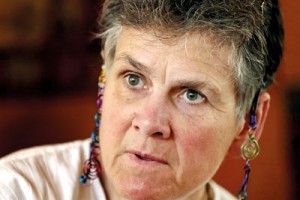News
Top Canadian Red Cross official back here to mark 10 years since 2004 tsunami
A major commitment has drawn to a close. She was back in Sri Lanka for three days in mid-November to commemorate the lives lost, recognise the lives rehabilitated and take stock of the lessons learnt.
In the country for the ‘T10 Summit’ hosted by the Sri Lanka Red Cross (SLRC), Pat Laberge is relaxed and smiling. She is the Senior Manager, Asia Programes, International Operations of the Canadian Red Cross (CRC). Just the thought of the time when she flew into Sri Lanka nearly 10 years ago to the death and devastation of the tsunami, however, takes her smile away as shadows of sorrow flit across her face.
Ms. Laberge was in Ottawa, Canada, in 2004, when the news of the Boxing Day disaster in Asia streamed into her home on television, making her still for a moment in shock.
Having joined the CRC back in 1994, she had been interacting with the SLRC since 1998 and was familiar with the coastal areas that had borne the brunt of the tsunami.
The immediate thought thereafter was the “big piece of work” that needed to follow. “We needed to do something to support SLRC in organising disaster relief,” she says.

Pic by M.A. Pushpa Kumara
Across the world, the reaction of the International Red Cross and Red Crescent Movement was instantaneous. “Money poured in,” recalls Ms. Laberge, for whom the yearning to join the Red Cross came as a little girl of about eight when she saw one of the visible humanitarian crises of our times in Biafra. (When Biafra seceded from the western African state of Nigeria during the period 1967-70, the conflict, starvation and disease are believed to have killed between 500,000 to several million.)
Experiencing through the news night after night, the heart-rending plight of the men, women and children in the throes of conflict and famine in Biafra, she realised that a constant factor was the Red Cross being there. It convinced her that “this is my work”. She wanted to be part of the largest humanitarian organisation, with access through its volunteer network, to the farthest and most remote areas of the world.
After joining the CRC, Ms. Laberge was a member of the humanitarian response after the genocide in Rwanda. She has not looked back since then, as her work took her to crisis-ridden nations such as Angola and Afghanistan.
In Sri Lanka, soon after the tsunami, the Red Cross and Red Crescent Movement’s emergency response got into gear, with the priority being search and rescue, restoring family links, first-aid, relief and psychosocial support. Later there would be the “challenges of recovery” in the form of permanent shelter, health and care, water and sanitation, livelihoods and disaster management.
Amidst the death, destruction, chaos, tears, sorrow and shock, there was an urgent need to set in place a coordinated system and it was for this vital task of ‘Movement Coordination’ that Ms. Laberge came in early January 2005, 10 days after the tsunami, to work with the SLRC. The CRC also channelled donations from both the Canadian government and public as part of its tsunami response.
It was crystal clear that the SLRC was not alone in the Herculean task of supporting the beleaguered people of Sri Lanka. According to Ms Laberge, of the 189 Red Cross and Red Crescent Societies spread across the world, 70 responded with initial aid. Thirty societies made a commitment to longer-term support, ranging from three to 10 years and established a partnership to work in the country with the SLRC for recovery and development.
She explains that when undertaking work in different areas, the SLRC in collaboration with the International Federation of Red Cross and Red Crescent Societies (IFRC) and the International Committee of the Red Cross (ICRC) would study the concept papers provided by each society and give approval for each to develop a full proposal and then implement it in an assigned area.
Based in an office down Gregory’s Road in Colombo 7, Ms. Laberge’s responsibility was the management of the Movement Coordination Framework. This ensured the coordination of the inputs from the 30 other Red Cross and Red Crescent Societies as well as liaising with the Sri Lankan Government and the United Nations through the coordination structures they had in place. The Movement Coordination Framework also had a Task Force and Technical Working Group to ensure coordination at operational and technical levels. The pivotal role in this overall coordination framework was played by the SLRC.
Conceding that at the beginning “it was a bit chaotic”, she says that the world had responded to Sri Lanka’s appeal. Everybody affected by the tsunami needed help, so it was important to get-together an efficient supply system, without stepping on each other’s toes and having overlaps.
Those were the days when her stress skyrocketed. In the first two or three months she had “to live without a lot of sleep”, getting shut-eye only for about 3-4 hours. “Everybody had my phone number,” she smiles, re-living those times.
“My phone never stopped ringing,” says Ms. Laberge, who worked closely with SLRC’s current Director-General Tissa Abeywickrama who was then heading the Task Force.
Numerous were the interactions with societies. With the tsunami devastation spreading across several geographical regions, decisions had to be taken as to which team would work where, avoiding overlaps, she says.
She demarcated on a map, four zones with an optimum number of teams working in each zone, covering all areas. “Some teams weren’t happy,” she says, adding that some wanted to work in every affected district. But they were advised to focus on one area and develop working relationships with smaller groups in that area.
Eighteen hours a day for around four months Ms. Laberge worked, her task in Sri Lanka lasting over 18 months.
With the firm belief that it is the role and responsibility of the Red Cross in each country to support the community’s needs, there is much poignancy when she talks of her last visit to Kabul in Afghanistan, en route to Sri Lanka in November.
When she met up with the Vice President of the Afghan Red Crescent Society (ARCS), in the line of people awaiting a meeting was a man with a child of about eight months. “The child who had open sores on her hands and feet was crying. It was heart-wrenching. Father and daughter were looking for support and they knew they could seek help from the ARCS,” says Ms. Laberge, adding without embarrassment that she was overcome by emotion.
Without hesitation, Ms. Laberge is quick to point out that the 18 months she served in Sri Lanka after the tsunami had wreaked havoc and mayhem, was the “hardest job I’ve ever done”. However, it is very much part of her job.
| Meeting to recognise efforts of tsunami aid workers The ‘T10 Summit’ linked to the 10th anniversary of the tsunami was held from November 15-17 to appreciate all those who helped in the tsunami response and also to shape future responses to disasters, said Mahieash Johnnie, IFRC’s Senior Manager for Communications and Humanitarian Diplomacy. |

